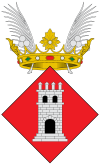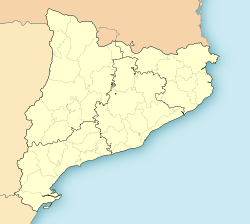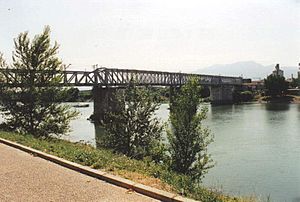Tortosa facts for kids
Quick facts for kids
Tortosa
|
|||
|---|---|---|---|
|
Municipality
|
|||
 |
|||
|
|||
| Country | Spain | ||
| Community | Catalonia | ||
| Province | Tarragona | ||
| Comarca | Baix Ebre | ||
| Area | |||
| • Total | 218.5 km2 (84.4 sq mi) | ||
| Elevation | 12 m (39 ft) | ||
| Population
(2018)
|
|||
| • Total | 33,510 | ||
| • Density | 153.36/km2 (397.21/sq mi) | ||
| Demonym(s) | Tortosí, tortosina | ||
| Climate | Csa | ||
Tortosa is an important city in Catalonia, Spain. It is the main city of the Baix Ebre area.
Tortosa is located about 12 meters (39 feet) above sea level. It sits right by the Ebro river. To the north, the city is protected by the Cardó Massif mountains. One of the highest peaks, Buinaca, is even inside Tortosa's city limits.
Across the river from Tortosa, you can see the huge Ports de Tortosa-Beseit mountains. The area around Mont Caro often gets covered in snow during winter.
Contents
City Areas in Tortosa
Tortosa is made up of several smaller towns and villages. Here are some of them and their populations:
- Bítem, 1,139 people (includes Santa Rosa)
- Campredó, 1,168 people
- Jesús, 3,755 people
- Els Reguers, 679 people
- Tortosa (the main city), 27,131 people
- Vinallop, 363 people (includes Mianes)
The city also has a small piece of land separate from the main area, located to the west.
A Look Back in Time: Tortosa's History
Tortosa has a very long history! It was once called Dertusa or Dertosa. It might even be the ancient city of Hibera, which was the capital of Ilercavonia. People have found old remains on a hill called Castillo de la Suda, which could be from this ancient settlement. When the Romans were in charge, the town was known as Dertosa.
Around the year 714, Tortosa was taken over during the Arab conquest of the Visigothic Kingdom. It stayed under Muslim rule for over 400 years. A king named Louis the Pious tried to capture Tortosa in 808–809. The city gave up, but he didn't manage to fully take control.
In 1148, the city was finally conquered by Count Ramon Berenguer IV, Count of Barcelona. This happened during the Second Crusade. Many crusaders from different countries helped in the siege. These included people from Genoa, England, France, Germany, and the Netherlands. They were on their way to the Holy Land. A writer from Genoa named Caffaro wrote about the siege of Tortosa.
After Tortosa was conquered, the city and its land were divided up. Some land was given to the foreign crusaders and to military and religious groups.
Long ago, there was a railway line that connected Tortosa to Alcañiz. This helped people travel between this region and Aragon. Work on the railway started in 1891, but it was slow. The first trains between Alcañiz and Tortosa didn't run until 1942. The last part of the line, from Tortosa to Sant Carles de la Ràpita, was never finished. The railway line was closed in 1973.
Cool Places to See in Tortosa
Tortosa has many interesting historical buildings and places to visit:
- Castle of Sant Joan, or Suda: This castle sits on a 59-meter (194-foot) high hill overlooking the city. The Romans first built defenses here. The castle you see today was built by the Muslim Caliph Abd ar-Rahman III. After the Christian conquest in 1148, it became a home for important families and later a royal palace.
- The Cathedral: This large church started being built in 1347. It was officially opened in 1597.
- Bishop Palace: Another historic building in the city.
- The Royal Schools: These schools were started by King Charles V to educate the Moors. They are a great example of Renaissance-style buildings in Catalonia. The Royal Schools have three parts:
- The College of Sant Jaume i Sant Maties (which now holds the local history records of Baix Ebre).
- The College of Sant Domènec i Sant Jordi.
- The Church of Sant Domènec (which is now a center that teaches about the Renaissance period).
- Convent of Santa Clara: This old convent was founded in 1283.
- The Rose Street: On this street, you can see several old palaces like Despuig Palace (from the 14th century), Oriol Palace, and Capmany Palace.
- Oliver de Boteller Palace (from the 15th century).
- Walls and fortresses: You can still see parts of the old city walls and forts like Tenasses, Sitjar, and Orleans.
- Buildings from the 19th and 20th centuries: These include the Municipal Market, the old Municipal Slaughterhouse (now the Museum of Tortosa), Montagut Palace, and many other interesting houses and buildings.
- Air-raid shelter number 4: This shelter was used during the Spanish Civil War and can be found on Ernest Hemingway Street.
Museums to Explore
If you like learning new things, Tortosa has some great museums:
- Tortosa Cathedral and its permanent exhibition: Here you can learn about the history of the cathedral and see its treasures.
- The Museum of Tortosa: This museum tells the story of the city.
- The Prince's Gardens: This is an outdoor museum with sculptures by Santiago de Santiago.
- The Renaissance Interpretation Centre: Located in the Church of Sant Domènec (part of the Royal Schools), this center helps you understand what life was like during the Renaissance.
- The Holy Week Interpretation Center: This center, located in St. Anthony Abbot's Church, explains the traditions of Holy Week.
Tortosa: A City of the Renaissance
Tortosa celebrates its history with a special event called the Tortosa Renaissance Festival.
- Over 3,000 people dress up in old costumes.
- There are more than 60 shows each day with over 500 actors.
- The festival takes you back in time to Tortosa 500 years ago, in the 16th century.
- It happens in the second half of July.
- The festival is called the Splendour of a 16th Century City. It celebrates one of the most interesting times in the city's past.
This festival is so important that it has been named a Fiesta of National Tourist Interest of Spain since 2005.
Nature Parks Around Tortosa
Tortosa is surrounded by beautiful natural areas:
- Ports de Tortosa-Beseit: These mountains are made of limestone and have steep cliffs. People have lived here since ancient times. They are located where Catalonia, Valencia, and Aragon meet.
- Ebro Delta: This is where the Ebro river meets the sea. It's a very important area for wildlife.
Tortosa's International Friends
Tortosa is "twinned" with several cities around the world. This means they have special friendly relationships:
 Avignon, France (since 1968)
Avignon, France (since 1968) Alcañiz, Spain (since 1972)
Alcañiz, Spain (since 1972) Vercelli, Italy (since 2003)
Vercelli, Italy (since 2003) Le Puy-en-Velay, France (since 2005)
Le Puy-en-Velay, France (since 2005) Tartus, Syria (since 2007)
Tartus, Syria (since 2007)
How Many People Live Here?
| 1991 | 1996 | 2001 | 2004 |
|---|---|---|---|
| 29,452 | 30,088 | 28,933 | 31,979 |
Tortosa's Weather
Tortosa has a warm hot-summer mediterranean climate. This means it has hot, dry summers and mild, wet winters. Even though it's a few miles inland, the city is on the delta of the Ebro river. This river helps protect the city from very cold weather. While it's a Mediterranean climate, winter months usually have less rain than autumn. There is still a significant dry period in summer.
| Climate data for Tortosa 50m (1981-2010). Extremes (1920-) | |||||||||||||
|---|---|---|---|---|---|---|---|---|---|---|---|---|---|
| Month | Jan | Feb | Mar | Apr | May | Jun | Jul | Aug | Sep | Oct | Nov | Dec | Year |
| Record high °C (°F) | 28.1 (82.6) |
26.3 (79.3) |
32.5 (90.5) |
33.9 (93.0) |
36.0 (96.8) |
39.6 (103.3) |
43.0 (109.4) |
41.1 (106.0) |
41.4 (106.5) |
34.5 (94.1) |
28.2 (82.8) |
25.6 (78.1) |
43.0 (109.4) |
| Mean daily maximum °C (°F) | 14.6 (58.3) |
16.4 (61.5) |
19.5 (67.1) |
21.5 (70.7) |
24.9 (76.8) |
29.4 (84.9) |
32.2 (90.0) |
32.3 (90.1) |
28.8 (83.8) |
24.0 (75.2) |
18.4 (65.1) |
14.9 (58.8) |
23.1 (73.6) |
| Daily mean °C (°F) | 10.1 (50.2) |
11.2 (52.2) |
13.8 (56.8) |
15.8 (60.4) |
19.2 (66.6) |
23.4 (74.1) |
26.3 (79.3) |
26.5 (79.7) |
23.2 (73.8) |
18.8 (65.8) |
13.9 (57.0) |
10.6 (51.1) |
17.7 (63.9) |
| Mean daily minimum °C (°F) | 5.6 (42.1) |
6.0 (42.8) |
8.1 (46.6) |
10.1 (50.2) |
13.4 (56.1) |
17.5 (63.5) |
20.3 (68.5) |
20.6 (69.1) |
17.5 (63.5) |
13.6 (56.5) |
9.3 (48.7) |
6.3 (43.3) |
12.4 (54.3) |
| Record low °C (°F) | −5.0 (23.0) |
−6.4 (20.5) |
−2.5 (27.5) |
0.1 (32.2) |
3.8 (38.8) |
9.2 (48.6) |
12.4 (54.3) |
12.4 (54.3) |
9.1 (48.4) |
3.6 (38.5) |
−2.0 (28.4) |
−3.8 (25.2) |
−6.4 (20.5) |
| Average precipitation mm (inches) | 33 (1.3) |
28 (1.1) |
30 (1.2) |
48 (1.9) |
58 (2.3) |
25 (1.0) |
15 (0.6) |
33 (1.3) |
59 (2.3) |
78 (3.1) |
60 (2.4) |
41 (1.6) |
508 (20.0) |
| Average precipitation days (≥ 1 mm) | 4 | 4 | 3 | 5 | 6 | 3 | 2 | 3 | 5 | 6 | 5 | 4 | 50 |
| Average relative humidity (%) | 65 | 63 | 60 | 59 | 60 | 58 | 57 | 60 | 64 | 68 | 67 | 67 | 62 |
| Mean monthly sunshine hours | 163 | 167 | 211 | 230 | 257 | 292 | 329 | 283 | 225 | 192 | 162 | 155 | 2,662 |
| Source: Agencia Estatal de Meteorología | |||||||||||||
Famous People from Tortosa
Many interesting people were born in or connected to Tortosa:
- Ibrahim ibn Yaqub (lived around 961-962): A traveler and merchant.
- Pope Adrian VI (1459–1523): He was the Pope of the Catholic Church from 1522 to 1523 and also the Bishop of Tortosa.
- Francesc Vicent Garcia: An early Catalan poet known as the Vallfogona Rector.
- Pedro de Alberní: A soldier who discovered Port Alberni in Canada.
- Ramón Cabrera y Griñó (1806–1877): A famous general during the Carlist Wars.
- Manuel Domingo y Sol (1836–1909): A Roman Catholic priest.
- Felipe Pedrell (1841–1922): A composer, guitarist, and music expert.
- Jaume Ferran i Clua: A Spanish scientist who studied bacteria and public health.
- Agustí Querol Subirats (1860–1909): A well-known sculptor.
- Rafael Vidiella (1890–1982): A trade union leader and communist politician.
- Pere Estupinyà (born 1974): A biochemist.
See also
 In Spanish: Tortosa para niños
In Spanish: Tortosa para niños





